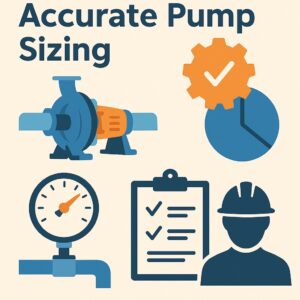Several industries rely on pumps to keep fluid flowing the way it should. Those include food and beverage production, pharmaceuticals, manufacturing, and water management to name a few. In each of those sectors, fluids must be moved safely, cleanly, and effectively. That entails taking numerous factors into account, such as the necessary flow rate, the viscosity of the fluid being transferred, and the hazards the pumps will be up against.

For engineers who work with hygienic fluid process equipment, picking the right size pump for an application is crucial. It can affect the performance of the system in question, its efficiency, and its long-term reliability. Read on to learn more about the science behind accurate pump sizing and some of the points every engineer should know about it.
Why Pump Sizing Is Important
First off, consider some of the reasons why pump sizing is important. If a pump is too large for a specific application, it can cause several problems. Those might include excessive energy consumption, vibration, and placing added wear and tear on not only the pump but also other components of the system it’s installed in.
On the other end of the spectrum, choosing a pump that’s too small can lead to a completely different set of issues. It won’t create the right pressure or flow rate, which could greatly affect the process the pump is being used for. Those problems can cause unnecessary downtime, product contamination, and many other situations. Selecting the right pump helps guarantee that systems operate at peak efficiency and effectiveness and meet the needs of their users.
Important Factors in Pump Sizing
An array of technical considerations come into play when choosing a pump for an application. One is the flow rate, which is the volume of fluid that needs to move through a system. It’s generally measured in gallons or liters per minute. Another is total dynamic head. That includes vertical lift, friction loss in pipes and fittings, and the pressure needed at the discharge point.
Fluid characteristics are another point to keep in mind when determining the right pump size. Those involve understanding the viscosities, temperatures, chemical properties, and other aspects of the fluids being pumped. The layout of the system in question also comes into play. The size of the system, distance fluid needs to travel, elevation changes, number of bends in the system, filters, and other variables also factor into determining the size and strength of the pump needed.
Additionally, hygienic requirements need to be considered. In hygienic fluid processes, pumps may need to meet a range of industry-specific standards and regulations. Those often pertain to a system’s cleanability and ensuring the materials it’s made of won’t react with the fluids running through the system it’s installed in. While these are common considerations for pump sizing, many other factors may also enter the mix.
Choosing the Best Pump for the Job
Finding the best pump size for the job at hand is essential. Choosing it early on in the system design process can help prevent the need for problematic changes later on while also ensuring that the system is capable of meeting the user’s needs. It’s important to avoid choosing a pump that’s too large or too small, but picking one that can handle a bit more pressure and stress than the anticipated requirements is also advised. That can help ensure that the pump will operate safely and effectively without needing excessive maintenance and repairs along the way.




